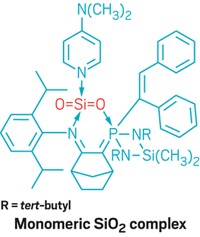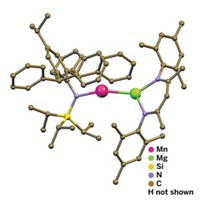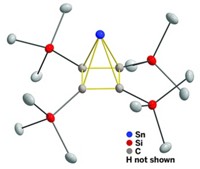Advertisement
Grab your lab coat. Let's get started
Welcome!
Welcome!
Create an account below to get 6 C&EN articles per month, receive newsletters and more - all free.
It seems this is your first time logging in online. Please enter the following information to continue.
As an ACS member you automatically get access to this site. All we need is few more details to create your reading experience.
Not you? Sign in with a different account.
Not you? Sign in with a different account.
ERROR 1
ERROR 1
ERROR 2
ERROR 2
ERROR 2
ERROR 2
ERROR 2
Password and Confirm password must match.
If you have an ACS member number, please enter it here so we can link this account to your membership. (optional)
ERROR 2
ACS values your privacy. By submitting your information, you are gaining access to C&EN and subscribing to our weekly newsletter. We use the information you provide to make your reading experience better, and we will never sell your data to third party members.
Synthesis
Mission Accomplished: a Stable Electride
Novel cryptand ligand leads to alkali-metal complex with a trapped electron as the counterion
by Stephen K. Ritter
October 10, 2005
| A version of this story appeared in
Volume 83, Issue 41
Persistence pays off. for 50 years, James L. Dye, an emeritus professor at Michigan State University, has been exploring the chemistry of alkali metals. In his career, he can claim a lot of firsts stemming from the elements in the first column of the periodic table. Now comes the coup de grce: synthesis of a room-temperature-stable electride, a compound in which the counterion in an alkali-metal cryptand complex is a trapped electron (J.Am. Chem. Soc. 2005, 127, 12416).
Alkali metals form some of the most simple and common compounds known, such as table salt, NaCl. But as Dye and others have shown over the years, the highly reactive elements also form some complex and unusual compounds, such as alkalides and electrides. Alkalides are compounds in which alkali-metal atoms adopt both the 1+ and 1- oxidation states in the same molecule: They serve as both the cation and the anion. Electrides are analogs of alkalides in which the alkali-metal cations are charge-balanced by electrons trapped in the crystal lattice.
Dye's group has made a few dozen alkalides since the late 1960s, but just a handful of electrides. A hurdle to the electrides, he notes, has been their thermal instability, which has required them to be prepared, isolated, and characterized at -20 C or below. As a result, the study of electrides has been a lonely venture, confined largely to our research group for the past 20 years, Dye relates.
Key to coming up with a stable electride now was the design and synthesis of a cryptand that could stand up to the electrons, which are powerful reducing agents. Cryptands are chelating ligands, similar to crown ethers, that have three ether chains held together by a common amine nitrogen atom at each end. The crypt is the central cavity of the cagelike ligand that is just the right size to bind an alkali-metal cation.
Dye knew from his earlier work that replacing the ether oxygen atoms in crown ethers and cryptands with tertiary amine nitrogen atoms greatly enhances their thermal stability. He turned to Michigan State chemistry professor James E. Jackson, who carried out a theoretical study of the ability of different aza-cryptands to complex alkali metals. They concluded that a cryptand with a piperazine ring in each of the three chains would allow optimum orientation of the nitrogen atoms for binding cations in the cryptand cavity.
Michigan State postdoc Mikhail Y. Redko accomplished what proved to be a tough synthesis of the ligand. It involved derivatizing a known aza-cryptand by adding ethyl groups between the nitrogen atoms on each chain to form the piperazine rings. The sodium cation was preencapsulated in the cryptand during the synthesis, and the electron anion was later incorporated during a metathesis reaction.
Departmental spectroscopist Rui H. Huang succeeded in growing crystals and elucidating the structure of the electride. The team also made the sodide analog in which a sodium anion is the counterion instead of an electron. The air-sensitive electride is stable up to about 40 °C before it begins to decompose into the sodide.

Dye's latest work is typical of his deliberate, broad, and very thorough investigations, observes chemistry professor John D. Corbett of Iowa State University and the Department of Energy's Ames Laboratory. Dye's first sodide isolation helped Corbett's group solve an old problem of isolating Zintl anions in crystalline salts some 30 years ago, Corbett says. Zintl compounds are small anionic clusters that can be trapped in the presence of alkali-metal cryptand or equivalent cations.
The whole team deserves credit for the design and nontrivial synthesis of the aza-cryptand and the characterization of the electride, Corbett adds. This result represents the solution to a very challenging goal.
It's likely that the search for new stable electrides will spread rapidly to other research groups, Dye says. The weakly bound electrons in the electrides make them potentially useful for photoelectron and thermoelectron emission, Dye notes. They could serve as infrared-sensitive detectors and thermionic power or refrigeration sources, he says. Dye's recent synthesis of powders of alkali metals with all-silica zeolites, which he thinks might be inorganic electrides, has led to the formation of a start-up company, SiGNa Chemistry (C&EN, June 20, page 24). The company is exploring use of the powders as reagents for hydrogen production and industrial organic synthesis.







Join the conversation
Contact the reporter
Submit a Letter to the Editor for publication
Engage with us on Twitter